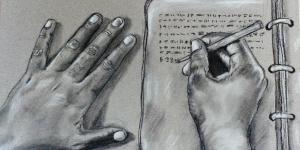You are here
Why Does Lehi Tell His Sons to “Arise from the Dust”?

2 Nephi 1:23
The Know
Shortly before his death, Lehi offered his sons personalized blessings. As he addressed his eldest sons, he implored them three times to “arise from the dust,” meaning to trust fully in the Lord and stay true to covenants they had made with Him (see 2 Nephi 1:14, 21, 23). Over the course of his sermon, Lehi gives other key instructions connected to rising from the dust, including the charge to “awake … [and] put on the armor of righteousness. Shake off the chains with which ye are bound, and come forth out of obscurity, and arise from the dust” (2 Nephi 1:23).
As has been noted by Jeff Lindsay, Lehi’s initial speech recorded in 2 Nephi 1 appears to draw on important themes found within the opening of Isaiah 52, which reads: “Awake, awake; put on thy strength, O Zion; put on thy beautiful garments, O Jerusalem, the holy city: for henceforth there shall no more come into thee the uncircumcised and the unclean. Shake thyself from the dust; arise, and sit down, O Jerusalem: loose thyself from the bands of thy neck, O captive daughter of Zion” (Isaiah 52:1–2).1
In Isaiah 52 and Lehi’s speech, themes of waking up, arising from the dust, putting on sacred clothing, and removing chains or shackles are clearly present. This prophecy of Isaiah also appears to have been influential among Nephi and his people, as Nephi appears to allude to this instruction in his psalm and Jacob expressly quotes it a few chapters later in a covenant-renewal sermon.2
One aspect that helps us understand why Lehi focused so much on rising from the dust can be found in Israelite coronations. This theme is clearly present in the Bible, as the Lord tells Baasha that when he was anointed king over Israel “I exalted thee out of the dust,” but because Baasha had not been faithful to his covenants the Lord would “take away the posterity of Baasha” (1 Kings 16:2–3). Commenting on this passage, Walter Brueggemann has noted that this passage is based on a “royal formula of enthronement” based on the statement in Genesis 3:19 that “dust thou art, and unto dust shalt thou return.” As such, “to be taken ‘from the dust’ means to be elevated from obscurity to royal office and to return to dust means to be deprived of that office and returned to obscurity.”3
Furthermore, Brueggemann notes that the imagery of being taken from the dust is heavily reliant on a covenant with a deity in the ancient Near Eastern world. So, when the king is taken from the dust, he is “accepted as a covenant-partner and treated graciously; to return to the dust means to lose that covenantal relation.” In other words, “to be ‘from dust’ is to enter covenant and to return ‘to dust’ is to have the covenant voided.”4 This is true in Isaiah’s passage as well.5 As Lindsay observes, when Isaiah instructs his sons to “shake thyself from the dust; arise, and sit down,” he is not telling them “to sit back down in the dust but rather to arise and sit on the throne that God has prepared.”6 Such statements are also found regarding death and renewal of life; thus, entering a covenant can be symbolic of resurrection based on this formula.7
Relying on a royal formula of enthronement would have been especially fitting given Lehi’s circumstances. As Lehi addresses Laman, Lemuel, Sam, and the sons of Ishmael, he informs them, “If ye will hearken unto the voice of Nephi ye shall not perish. And if ye will hearken unto him I leave unto you a blessing, yea, even my first blessing. But if ye will not hearken unto him I take away my first blessing, yea, even my blessing, and it shall rest upon [Nephi]” (2 Nephi 1:28–29). As noted by Lindsay, this passage recalls the Lord’s “earlier promise to Nephi, conditional on his obedience, that he would be a teacher and a ruler over his brethren (1 Nephi 2:22).”8 Because Laman and Lemuel consistently rebelled against the Lord, failing to “arise from the dust,” they lost their right to rule.
However, such was not the case for Nephi, who “through his faithfulness and his writings demonstrates that he has responded to Lehi’s teachings in 2 Nephi 1, though directed to others, and fully qualifies as Lehi’s successor both spiritually and politically.”9 Writing his psalm following Lehi’s death, Nephi “fortifies his acceptance of Lehi’s plea when he asks God in verse 31 to make him that he ‘may shake at the appearance of sin,’ following Lehi’s command to ‘shake off the chains with which ye are bound’ and complying with Isaiah 52:2, ‘Shake thyself from the dust.’”10 In so doing, Nephi is accepting the blessing of leadership that had been promised to him by his father and the Lord because of his faithfulness.
The motif of dust in relation to Nephite kings and leaders continued to play an important role throughout Nephite history. As mentioned above, Jacob cited Isaiah 52:1–2 in a covenant-renewal setting that likely mirrored the Feast of Tabernacles, which also could serve as a ritual coronation for Israelite kings. By citing these passages at this time, Jacob could be referencing his brother’s blessing and rulership over the people.11 Similarly, in Mosiah 2:25–26, King Benjamin “invokes the theme of dust to humbly remind his people that he is no better than they are” shortly before announcing that his son Mosiah would be made a king over the people of Zarahemla.12
The Why
The call to arise from the dust would have been especially powerful in the minds of ancient Israelites, who would have recognized it as a call to enter into a covenant with God and accept the high blessings He desires to bestow upon His children. This is made more significant when Nephi’s response to his father is contrasted with Laman and Lemuel’s.
While Laman and Lemuel repeatedly showed signs of repentance following their rebellions during their journeys, they consistently returned to their old ways. Neal A. Maxwell once noted, “Laman and Lemuel became rebels instead of leaders, resentful instead of righteous—all because of their failure to understand either the character or the purposes of God.”13 By consistently rejecting the opportunity to enter into a covenant with God whereby their father’s blessing could be bestowed upon them, Laman and Lemuel forfeited their position to their younger brother, Nephi, because he showed the Lord that he would be true to his covenants and help his people come closer to their Savior, Jesus Christ.
Although initially directed to his children, Lehi’s instructions to “arise from the dust” are applicable to modern readers of the Book of Mormon. Jeff Lindsay has noted, “Rising from the dust is tied to divine covenants. To keep them is to rise from the dust but not only to rise but to be endowed … with power and authority.”14 All God’s children are invited to make and keep sacred covenants with Him, and therefore we can all “arise from the dust” as we stay true to the covenants we make at baptism and in the temple.
This theme is especially prominent at the end of the Book of Mormon. There Moroni revisits Isaiah 52 as he exhorts modern readers to “awake, and arise from the dust, O Jerusalem; yea, and put on thy beautiful garments, O daughter of Zion; and strengthen thy stakes and enlarge thy borders forever, that thou mayest no more be confounded, that the covenants of the Eternal Father which he hath made unto thee, O house of Israel, may be fulfilled” (Moroni 10:31).
The beautiful garments Moroni mentions (which are analogous to Lehi’s armor of God) “may well refer to the robes and garments of the Temple, where we lay hold of every good gift and learn to cast out Satan and reject his evil gifts” and where each faithful follower of the Lord Jesus Christ is blessed with the ability and power to come forth eternally in righteousness and glory as a heavenly king or queen, priest or priestess, unto God. Thus, Moroni concludes by calling us and all his readers “to come forth out of obscurity and arise from the dust as we keep our covenants with God and receive the grace and good gifts God offers those who come unto Christ.”15
Further Reading
Jeff Lindsay, “‘Arise from the Dust’: Insights from Dust-Related Themes in the Book of Mormon (Part 2: Enthronement, Resurrection, and Other Ancient Motifs from the ‘Voice from the Dust’),” Interpreter: A Journal of Latter-day Saint Faith and Scholarship 22 (2016): 233–277.
Book of Mormon Central, “Why Does Isaiah Prophesy of the Daughter of Zion? (2 Nephi 13:16–17),” KnoWhy 550 (February 18, 2020).
- 1. Jeff Lindsay, “‘Arise from the Dust’: Insights from Dust-Related Themes in the Book of Mormon (Part 2: Enthronement, Resurrection, and Other Ancient Motifs from the ‘Voice from the Dust’),” Interpreter: A Journal of Latter-day Saint Faith and Scholarship 22 (2016): 236–238.
- 2. For the context to Jacob’s sermon, see Book of Mormon Central, “Did Jacob Refer to Ancient Israelite Autumn Festivals? (2 Nephi 6:4),” KnoWhy 32 (February 12, 2016). It is also worth observing that this same chapter (although not the same verse) of Isaiah would be influential in Abinadi’s ministry, as the priests of Noah would dispute with him the meaning of Isaiah 52:7. See Mosiah 12:21; 15:14–21.
- 3. Walter Brueggemann, “From Dust to Kingship,” Zeitschrift für die Alttestamentliche Wissenschaft 84, no. 1 (1972): 2.
- 4. Brueggemann, “From Dust to Kingship,” 2–3.
- 5. This image is found in other prophecies of Isaiah. In these oracles, the daughter of Zion, a personification of the city of Jerusalem and the whole house of Israel by extension, is elsewhere disrobed and unendowed for her wickedness. Only by returning to the Lord and being faithful to its covenants could Israel arise from its naked and filthy state, thus becoming a symbol for the glorification and enthronement of Israel. See Book of Mormon Central, “Why Does Isaiah Prophesy of the Daughter of Zion? (2 Nephi 13:16–17),” KnoWhy 550 (February 18, 2020), for greater discussion on this principle.
- 6. Lindsay, “‘Arise from the Dust,’” 237–238.
- 7. The primary study on this topic can be found in J. Wijngaards, “Death and Resurrection in Covenantal Context (Hos. VI 2),” Vetus Testamentum 17, no. 2 (1967): 226–239. Jeff Lindsay also summarizes it briefly in Lindsay, “‘Arise from the Dust,’” 239.
- 8. Lindsay, “‘Arise from the Dust,’” 241.
- 9. Lindsay, “‘Arise from the Dust,’” 241.
- 10. Lindsay, “‘Arise from the Dust,’” 238.
- 11. For a discussion on Jacob’s use of Isaiah in his speech hinting at this Israelite holiday, see John S. Thompson, “Isaiah 50–51, the Israelite Autumn Festivals, and the Covenant Speech of Jacob in 2 Nephi 6–10,” in Isaiah in the Book of Mormon, ed. Donald W. Parry and John W. Welch (Provo, UT: FARMS, 1998), 124–150.
- 12. Lindsay, “‘Arise from the Dust,’” 243; see Mosiah 2:30. It is also possible that the priests of Noah drew upon the royal imagery of this chapter in asserting their royal prerogatives over the people in the land of Nephi.
- 13. Neal A. Maxwell, “Lessons from Laman and Lemuel,” Ensign, November 1999, 8.
- 14. Lindsay, “‘Arise from the Dust,’” 240.
- 15. Lindsay, “‘Arise from the Dust,’” 245.
KnoWhy Citation
Related KnoWhys
Subscribe
Get the latest updates on Book of Mormon topics and research for free





